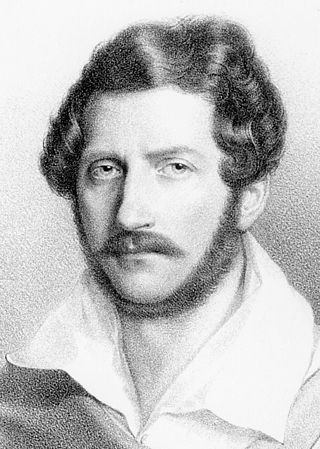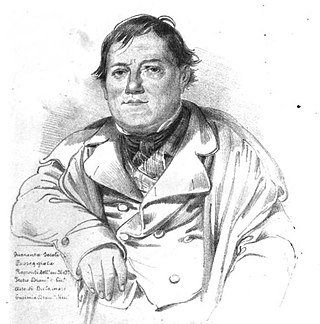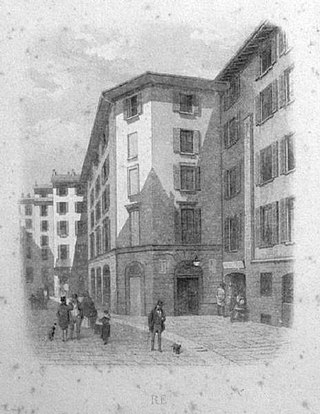
Giuseppe Persiani was an Italian opera composer.

Pia de' Tolomei is a tragedia lirica in two acts by Gaetano Donizetti. Salvadore Cammarano wrote the Italian libretto after Bartolomeo Sestini's verse novella Pia de' Tolomei, which was based on Canto V, vv. 130–136 from Dante's narrative poem The Divine Comedy part 2: Purgatorio. It premiered on 18 February 1837 at the Teatro Apollo in Venice.

Gianni di Parigi is an 1839 melodramma comico in two acts with music by Gaetano Donizetti to a libretto by Felice Romani, which had previously been set by Francesco Morlacchi in 1818 and by Giovanni Antonio Speranza in 1836.
Giuseppe Farinelli was an Italian composer active at the end of the 18th century and the beginning of the 19th century who excelled in writing opera buffas. Considered the successor and most successful imitator of Domenico Cimarosa, the greatest of his roughly 60 operas include I riti d'Efeso, La contadina bizzarra and Ginevra degli Almieri. More than 2/3 of his operas were produced between 1800-1810 at the height of his popularity. With the arrival of Gioachino Rossini his operas became less desirable with the public, and by 1817 his operas were no longer performed. His other compositions include 3 piano forte sonatas, 3 oratorios, 11 cantatas, 5 masses, 2 Te Deums, a Stabat mater, a Salve regina, a Tantum ergo, numerous motets, and several other sacred works.
Tomaso Benvenuti was a nineteenth-century Italian composer of opera. He was born in Cavarzere in the Veneto and died in Rome at the age of 68.

Giuseppe Lillo was an Italian composer. He is best known for his operas which followed in the same vein of Gioachino Rossini. He also produced works for solo piano, a small amount of sacred music, and some chamber music.

Salvator Rosa is an opera seria in four acts composed by Antônio Carlos Gomes to a libretto in Italian by Antonio Ghislanzoni. It premiered at the Teatro Carlo Felice in Genoa on 21 March 1874. The plot is based on Eugène de Mirecourt's 1851 adventure novel, Masaniello, in turn loosely based on the lives of the Italian painter and poet, Salvator Rosa and Masaniello, a Neapolitan fisherman, who became leader of the 1647 revolt against the Spanish Habsburg rule in Naples.
Pasquale Bona was an Italian composer. He studied music in Palermo. He composed a number of operas, including one based on the Schiller play that would later inspire Giuseppe Verdi's Don Carlos. Bona later taught at the Conservatory in Milan, where he counted among his pupils Amilcare Ponchielli, Arrigo Boito, Franco Faccio and Alfredo Catalani; he was also friends with Alessandro Manzoni.
Domenico Gilardoni (1798–1831) was an Italian opera librettist, most well known for his collaborations with the composers Vincenzo Bellini and Gaetano Donizetti.

Don Bucefalo is an opera in three acts composed by Antonio Cagnoni to a libretto by Calisto Bassi. Bassi's libretto was based on the libretto by Giuseppe Palomba to Le cantatrici villane (1799) by Valentino Fioravanti. Don Bucefalo premiered on 28 June 1847 at the Milan Conservatory.
Feliciano Cristoforo Bartolomeo Strepponi was an Italian composer and conductor. He was born in Lodi and died in Trieste at the age of 38. Amongst his compositions were seven operas which had a modest success in their day. The last one, L'Ullà di Bassora, premiered at La Scala in 1831. He was the father and first teacher of the opera singer Giuseppina Strepponi who later became the second wife of Giuseppe Verdi.
Nitocri is an opera in two acts composed by Saverio Mercadante to libretto by Apostolo Zeno adapted by Lodovico Piossasco Feys. The libretto is a fictionalised account of the Egyptian queen Nitocris. The opera premiered at the Teatro Regio in Turin on 26 December 1824.
Ermanno Picchi was an Italian composer, pedagogue and music critic who played an active role in the musical life of Florence from 1836 until his early death in 1856.
Giuseppe Balducci was an Italian composer, primarily of operas. Born in Iesi, he spent most of his career in Naples and was one of the originators of the "salon opera" genre, the forerunner of chamber opera.

Nicola De Giosa was an Italian composer and conductor active in Naples. He composed numerous operas, the most successful of which, Don Checco and Napoli di carnevale, were in the Neapolitan opera buffa genre. His other works included sacred music and art songs. His songs were particularly popular, bringing him fame as a salon composer both in Italy and abroad. De Giosa died in Bari, the city of his birth, at the age of 66.
Almerindo Spadetta was a prolific opera librettist active in Naples. He worked as a stage manager at the Teatro San Carlo, Teatro Nuovo, and Teatro del Fondo in Naples for over 40 years and wrote numerous libretti for composers associated with those theatres. His most enduring work was the libretto for Nicola De Giosa's Don Checco, one of the last great successes in the history of Neapolitan opera buffa.
Giuseppe Puzone was an Italian opera composer and conductor active in Naples, the city of his birth. He was for many years the principal conductor of the Teatro San Carlo where his opera Elfrida di Salerno had premiered in 1849. He composed three other operas, all of which premiered in Naples, as well as sacred and symphonic music.

Giovanni Emanuele Bidera was an Italian writer.

The Teatro Re was a theatre in Milan, located near the Piazza del Duomo and named for its proprietor, Carlo Re. It functioned as both a prose theatre and an opera house and saw the world premieres of numerous operas, including four by Giovanni Pacini. Designed by Luigi Canonica, the theatre was inaugurated in 1813, closed in 1872, and demolished in 1879.
Le due duchesse or La caccia dei lupi is a semiseria opera in two acts by Johann Simon Mayr to a libretto by Felice Romani which was premiered 7 November 1814 at La Scala in Milan and revived in 1819 at the Teatro San Carlo, Naples. Romani used his libretto again with a few changes for a new setting by Filippo Celli (1782–1856) for Florence on 8 September 1824.









